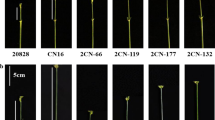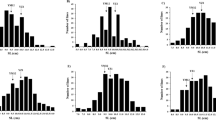Abstract
Key message
A major QTL QSpl.nau-7D, named HL2, was validated for its effects on head length and kernel number per spike using NIL, and mapped to a 0.2 cM interval using recombinants.
Abstract
Improvement in wheat inflorescence traits such as spike or head length and spikelet number provides an important avenue to increase grain yield potential. In a previous study, QSpl.nau-7D, the major QTL for head length on chromosome 7D, was identified in the recombinant inbred lines derived from Nanda2419 and Wangshuibai. To validate and precisely map this QTL, the Wangshuibai allele was transferred to elite cultivar Yangmai15 through marker-assisted selection. Compared with the recurrent parent, the resultant near-isogenic line (NIL) yielded not only 28% longer spikes on the average but also more spikelets and kernels per spike. Moreover, the NIL had a lower spikelet density and did not show significant kernel weight change. In the F2 population derived from the NIL, QSpl.nau-7D acted like a single semi-dominant gene controlling head length and was therefore designated as Head Length 2 (HL2). With this population, a high-density genetic map was constructed mainly using newly developed markers, and 100 homozygous recombinants including 17 genotypes were obtained. Field experiments showed that the recombinants carrying the 0.2-cM interval flanked by Xwgrb1588 and Xwgrb1902 from Wangshuibai produced longer spikes than those without this Wangshuibai allele. Comparative mapping of this interval revealed a conserved synteny among cereal grasses. HL2 is beneficial to wheat breeding for more kernels per spike at a lower spikelet density, which is a favored morphological trait for Fusarium head blight resistance.






Similar content being viewed by others
References
Avni R, Nave M, Barad O et al (2017) Wild emmer genome architecture and diversity elucidate wheat evolution and domestication. Science 357:93–97
Boden SA, Cavanagh C, Cullis BR, Ramm K, Greenwood J, Finnegan EJ, Trevaskis B, Swain SM (2015) Ppd-1 is a key regulator of inflorescence architecture and paired spikelet development in wheat. Nat Plants 1:14016
Cui F, Ding A, Li J, Zhao C, Wang L, Wang X, Qi X, Li X, Li G, Gao J, Wang H (2012) QTL detection of seven spike-related traits and their genetic correlations in wheat using two related RIL populations. Euphytica 186:177–192
Debernardi JM, Lin H, Faris JD, Dubcovsky J (2017) microRNA172 plays a critical role in wheat spike morphology and grain threshability. Development 144:1966–1975
Deng S, Wu X, Wu Y, Zhou R, Wang H, Jia J, Liu S (2011) Characterization and precise mapping of a QTL increasing spike number with pleiotropic effects in wheat. Theor Appl Genet 122:281–289
Deng Z, Cui Y, Han Q, Fang W, Li J, Tian J (2017) Discovery of consistent QTLs of wheat spike-related traits under nitrogen treatment at different development stages. Front Plant Sci 8:2120
Dixon LE, Greenwood JR, Bencivenga S, Zhang P, Cockram J, Mellers G, Ramm K, Cavanagh C, Swain SM, Boden SA (2018) TEOSINTE BRANCHED1 regulates inflorescence architecture and development in bread wheat (Triticum aestivum). Plant Cell 30:563–581
Dobrovolskaya O, Pont C, Sibout R et al (2015) FRIZZY PANICLE drives supernumerary spikelets in bread wheat. Plant Physiol 167:189–199
Faris JD, Fellers JP, Brooks SA, Gill BS (2003) A bacterial artificial chromosome contig spanning the major domestication locus Q in wheat and identification of a candidate gene. Genetics 164:311–321
Faris JD, Zhang Q, Chao S, Zhang Z, Xu SS (2014) Analysis of agronomic and domestication traits in a durum × cultivated emmer wheat population using a high-density single nucleotide polymorphism-based linkage map. Theor Appl Genet 127:2333–2348
Feng N, Song G, Guan J, Chen K, Jia M, Huang D, Wu J, Zhang L, Kong X, Geng S, Liu J, Li A, Mao L (2017) Transcriptome profiling of wheat inflorescence development from spikelet initiation to floral patterning identified stage-specific regulatory genes. Plant Physiol 174:1779–1794
Greenwood JR, Finnegan EJ, Watanabe N, Trevaskis B, Swain SM (2017) New alleles of the wheat domestication gene Q reveal multiple roles in growth and reproductive development. Development 144:1959–1965
Heidari B, Sayed-Tabatabaei BE, Saeidi G, Kearsey M, Suenaga K (2011) Mapping QTL for grain yield, yield components, and spike features in a doubled haploid population of bread wheat. Genome 54:517–527
Huang Y, Haas M, Heinen S, Steffenson BJ, Smith KP, Muehlbauer GJ (2018) QTL mapping of fusarium head blight and correlated agromorphological traits in an elite barley cultivar Rasmusson. Front Plant Sci 9:1260
IWGSC (2018) Shifting the limits in wheat research and breeding using a fully annotated reference genome. Science 361:eaar7191
Jantasuriyarat C, Vales M, Watson C, Riera-Lizarazu O (2004) Identification and mapping of genetic loci affecting the free-threshing habit and spike compactness in wheat (Triticum aestivum L.). Theor Appl Genet 108:261–273
Jones S, Farooqi A, Foulkes J, Sparkes DL, Linforth R, Ray RV (2018) Canopy and ear traits associated with avoidance of Fusarium head blight in wheat. Front Plant Sci 9:1021
Li C, Zhu H, Zhang C, Lin F, Xue S, Cao Y, Zhang Z, Zhang L, Ma Z (2008) Mapping QTLs associated with Fusarium-damaged kernels in the Nanda 2419 × Wangshuibai population. Euphytica 163:185–191
Liu P, Liu J, Dong H, Sun J (2017) Functional regulation of Q by microRNA172 and transcriptional co-repressor TOPLESS in controlling bread wheat spike density. Plant Biotechnol J 16:495–506
Liu K, Sun X, Ning T, Duan X, Wang Q, Liu T, An Y, Guan X, Tian J, Chen J (2018) Genetic dissection of wheat panicle traits using linkage analysis and a genome-wide association study. Theor Appl Genet 131:1073–1090
Ma Z, Sorrells ME (1995) Genetic analysis of fertility restoration in wheat using restriction fragment length polymorphisms. Crop Sci 35:1137–1143
Ma Z, Zhao D, Zhang C, Zhang Z, Xue S, Lin F, Kong Z, Tian D, Luo Q (2007) Molecular genetic analysis of five spike-related traits in wheat using RIL and immortalized F2 populations. Mol Genet Genomics 277:31–42
Maydup ML, Antonietta M, Guiamet JJ, Graciano C, López JR, Tambussi EA (2010) The contribution of ear photosynthesis to grain filling in bread wheat (Triticum aestivum L.). Field Crop Res 119:48–58
Poursarebani N, Seidensticker T, Koppolu R et al (2015) The genetic basis of composite spike form in barley and ‘Miracle-Wheat’. Genetics 201:155–165
Sanchez-Bragado R, Molero G, Reynolds MP, Araus JL (2014) Relative contribution of shoot and ear photosynthesis to grain filling in wheat under good agronomical conditions assessed by differential organ δ13C. J Exp Bot 65:5401–5413
Simons KJ, Fellers JP, Trick HN, Zhang Z, Tai YS, Gill BS, Faris JD (2006) Molecular characterization of the major wheat domestication gene Q. Genetics 172:547–555
Suzuki T, Sato M, Takeuchi T (2012) Evaluation of the effects of five QTL regions on Fusarium head blight resistance and agronomic traits in spring wheat (Triticum aestivum L.). Breed Sci 62:11–17
Van Ooijen JW (2006) JoinMap® 4, software for the calculation of genetic linkage maps in experimental populations. Wageningen, Kyazma BV
Voorrips RE (2002) MapChart: software for the graphical presentation of linkage maps and QTLs. J Hered 93:77–78
Wang S, Wong D, Forrest K et al (2014) Characterization of polyploid wheat genomic diversity using a high-density 90 000 single nucleotide polymorphism array. Plant Biotechnol J 12:787–796
Wang Y, Yu H, Tian C, Sajjad M, Gao C, Tong Y, Wang X, Jiao Y (2017) Transcriptome association identifies regulators of wheat spike architecture. Plant Physiol 175:746–757
Wu X, Cheng R, Xue S, Kong Z, Wan H, Li G, Huang Y, Jia H, Jia J, Zhang L, Ma Z (2014) Precise mapping of a quantitative trait locus interval for spike length and grain weight in bread wheat (Triticum aestivum L.). Mol Breed 33:129–138
Xie Q, Mayes S, Sparkes DL (2015) Spelt as a genetic resource for yield component improvement in bread wheat. Crop Sci 55:2753–2765
Xie Q, Li N, Yang Y, Lv Y, Yao H, Wei R, Sparkes DL, Ma Z (2018) Pleiotropic effects of the wheat domestication gene Q on yield and grain morphology. Planta 247:1089–1098
Xu H, Yao G, Xiong L, Yang L, Jiang Y, Fu B, Zhao W, Zhang Z, Zhang C, Ma Z (2008) Identification and mapping of pm2026: a recessive powdery mildew resistance gene in an einkorn (Triticum monococcum L.) accession. Theor Appl Genet 117:471–477
Zamir D (2001) Improving plant breeding with exotic genetic libraries. Nat Rev Genet 2:983–989
Zhai H, Feng Z, Li J, Liu X, Xiao S, Ni Z, Sun Q (2016) QTL analysis of spike morphological traits and plant height in winter wheat (Triticum aestivum L.) using a high-density SNP and SSR-based linkage map. Front Plant Sci 7:1617
Acknowledgements
This study was partially supported by grants from Natural Science Foundation of China (31430064), National Key Research and Development Program of China (2016YFD0100402), Natural Science Foundation of China (31801354, 31271711), Natural Science Foundation of Jiangsu Province, China (BK20160714), Jiangsu Collaborative Innovation Initiative for Modern Crop Production, ‘111’ Project (B08025) and Fundamental Research Funds for the Central Universities (KYZ201801).
Author information
Authors and Affiliations
Corresponding author
Ethics declarations
Conflict of interest
The authors declare that they have no conflicts of interest.
Additional information
Communicated by Steven S. Xu.
Publisher's Note
Springer Nature remains neutral with regard to jurisdictional claims in published maps and institutional affiliations.
Electronic supplementary material
Below is the link to the electronic supplementary material.
Rights and permissions
About this article
Cite this article
Yao, H., Xie, Q., Xue, S. et al. HL2 on chromosome 7D of wheat (Triticum aestivum L.) regulates both head length and spikelet number. Theor Appl Genet 132, 1789–1797 (2019). https://doi.org/10.1007/s00122-019-03315-2
Received:
Accepted:
Published:
Issue Date:
DOI: https://doi.org/10.1007/s00122-019-03315-2




